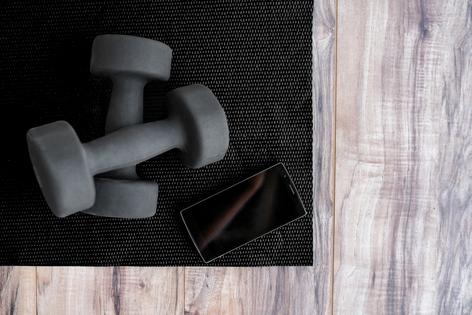Mayo Clinic Q&A: Top 10 workout myths
Published in Health & Fitness
DEAR MAYO CLINIC: I eat fairly healthy, but I want to lose weight and improve my physical wellness in the new year. I’m finding a lot of conflicting information about the best workouts for weight loss, the amount of time I need to work out and what food I should eat. Can you help me make sense of it so I can plan a routine?
ANSWER: Being proactive to achieve long-term health and wellness is important, and you should be proud of your efforts to set fitness goals and develop routines. However, among research, personal opinion and stereotypes, a lot of misinformation can make it hard to know what is accurate.
Here is the truth about the top 10 workout myths that you should consider as you develop your game plan:
Myth 1: Stick solely to cardio for weight loss.
While it’s true that you should include 20-30 minutes of cardio in your workout routine, focusing solely on cardio will not transform your body as quickly or as dramatically as you might think.
People perceive cardio as the ultimate solution because their heart rate is up. But in reality, you need to incorporate both cardio and strength training into your workout. Strength training builds muscles and maximizes your cardio routine. The more muscle you have, the more calories your body will burn, especially during cardio.
Myth 2: Heavy weights will bulk you up.
Some people are concerned that adding strength training will build muscle bulk to the point that they will look like a bodybuilder. This is not true. You would have to work out excessively to do so. Start slow and add weight to build muscle, which will maximize the calories your body will burn.
Myth 3: If you work out today, you can be lax in your diet.
Working out is important, but so is having good nutrition. You can’t work off a bad diet. Food is fuel, and proper nutrition guarantees results. If you want to lose weight, your calorie output needs to be higher than your calorie input.
Myth 4: Stretching helps prevent injuries.
If you grew up playing sports, stretching before a game was a regular routine. However, you might be surprised to learn that while stretching is beneficial — because it prepares the muscles for movement and eases your workout recovery — there is no proven research that it will reduce your chances of getting an injury. That’s entirely based on your form and movements during a workout. Use functional, dynamic stretches like lunges and leg swings to help muscle movement during workouts.
Myth 5: If the number on the scale isn’t going down, you’re not losing weight.
Many people focus on the number on the scale, but it is not the best representation of body changes. The number on the scale is a factor of many things, including how much water you’ve consumed, what you ate and when you’re weighing in. Often when a person loses a significant amount of weight, the number on the scale goes up because of building muscle from exercise.
If you want to accurately track your weight loss and muscle development, record measurements of your arms, waist and thighs. And if you’re going to use the scale, weigh yourself at the same time every day.
Myth 6: Cardio machines count burned calories with 100% accuracy.
Some people depend on the treadmill to tell them an exact number of calories burned during a workout. Unfortunately, this metric isn’t 100% accurate. Many factors determine how many calories your body burns, including your sex, age and current weight. Some machines allow you to enter personalized data in one or two of these factors but rarely all three.
Myth 7: Sticking to ab workouts will give you a six-pack.
Abdominal workouts are great for developing core muscles because they benefit your body in many ways, such as improving your balance and stability. However, a person’s overall body fat prevents abs from being seen. If you want six-pack abs, you have to dramatically decrease your body fat to 10%-12% for men or 11%-13% for women. While possible, this requires strict dedication to eating a healthy diet and exercising.
Myth 8: Supplements and protein shakes are necessary after workouts.
Supplements and protein shakes are not necessary. The benefits they offer are available from natural and direct food sources, such as chocolate milk, turkey or a scoop of peanut butter. The truth is you don’t need supplements and shakes to get proper nutrients. You can get those nutrients from other food sources. If you consume protein-rich foods after a workout, do so within 30 minutes. That’s when your muscles absorb that energy, as they’re still burning and working.
Myth 9: If you’re not working up a sweat, you’re not working hard enough.
Sweating is an inaccurate way to measure your workout. Many factors go into the amount a person sweats, such as the temperature, humidity and hydration levels. Your body just could be efficient at cooling itself, as well.
Myth 10: No pain, no gain.
While feeling uncomfortable during a workout is normal, feeling pain is not. Many athletes live by the “no pain, no gain” motto, but pain is the way your body tells you that something is wrong. If you start to feel pain during a workout, stop immediately. If you continue to push through it, you could end up with a serious injury. — David Webster, Orthopedics, Mayo Clinic Health System in Eau Claire, Wisconsin
(Mayo Clinic Q & A is an educational resource and doesn’t replace regular medical care. E-mail a question to MayoClinicQ&A@mayo.edu. For more information, visit www.mayoclinic.org.)
©2021 Mayo Foundation for Medical Education and Research. All Rights Reserved. Distributed by Tribune Content Agency, LLC.







Comments